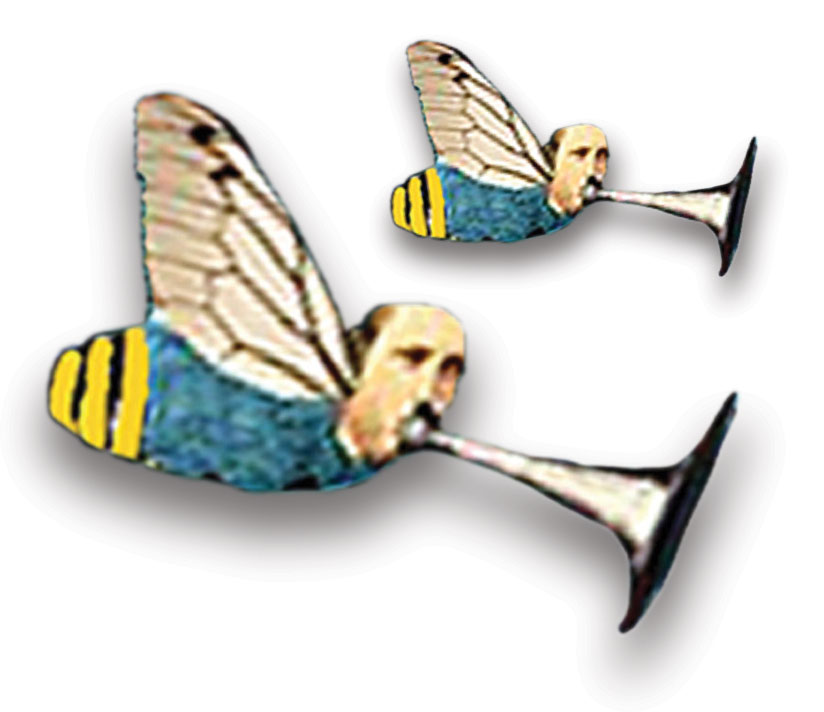|
 |
Tinnitus: The Thief of Silence
BY CLAUDIA GARY
 Whatever the cause—a sudden extreme noise, an accumulation of noise exposure, a head or neck injury, an infection such as Lyme disease, a blood vessel disease, a medication side effect, temporomandibular joint disorder, or something else—the result can be devastating. Tinnitus can be a nuisance or it can be a disabling condition. Whatever the cause—a sudden extreme noise, an accumulation of noise exposure, a head or neck injury, an infection such as Lyme disease, a blood vessel disease, a medication side effect, temporomandibular joint disorder, or something else—the result can be devastating. Tinnitus can be a nuisance or it can be a disabling condition.
The American Tinnitus Association (ATA) defines the condition as “the perception of sound when no external sound is present,” but it is most commonly described as a ringing in the ears. Actor William Shatner said in an ATA video that tinnitus has “robbed silence from the lives of nearly 50 million Americans.” Shatner said his own tinnitus was caused by “standing too close to a special effects explosion.” It prompted him to reach out to veterans, offering information and hope.
The Department of Veterans Affairs calls tinnitus “the number one disability among veterans, and it affects at least one in every ten American adults.” This includes nearly half of all service personnel exposed to improvised explosive devices in Iraq and Afghanistan, according to a study at Walter Reed Army Medical Center.
The decibel level of an IED detonation is at least 140 dBA. The sound output of a 9mm pistol is 157 dBA; a 5.56mm automatic weapon fired from a Humvee exposes a gunner to 160 dBA. A grenade at 50 feet puts out 164 dBA, and a 105mm towed howitzer exposes its gunner to 183 dBA. Yet hearing damage can occur at 80 dBA.
According to ATA, the VA’s 2009 figure of more than 760,000 veterans receiving service-connected tinnitus disability could, at the current rate, increase to more than 1.5 million by 2014. In the same period, the expected compensation would more than double from $1.12 billion to $2.26 billion. In contrast, the expenditure by organizations for research into better treatments and a possible cure was about $10 million in 2009. According to ATA, “the Army is the only branch of the military that requires ear plugs as part of its uniform.”
STUDYING SILENCE
 “A lot can be done for tinnitus,” said Dr. James Henry, research professor in otolaryngology at the Oregon Health and Science University and one of the authors of the Progressive Tinnitus Management approach now used at VA medical centers. The approach includes a hearing exam, sound therapy (including soothing sounds, background sounds, and what are called “interesting sounds” to shift focus away from the tinnitus), and cognitive behavioral therapy to develop coping techniques. Henry is also on the Scientific Advisory Committee of ATA, whose mission is to find an actual cure for tinnitus. “A lot can be done for tinnitus,” said Dr. James Henry, research professor in otolaryngology at the Oregon Health and Science University and one of the authors of the Progressive Tinnitus Management approach now used at VA medical centers. The approach includes a hearing exam, sound therapy (including soothing sounds, background sounds, and what are called “interesting sounds” to shift focus away from the tinnitus), and cognitive behavioral therapy to develop coping techniques. Henry is also on the Scientific Advisory Committee of ATA, whose mission is to find an actual cure for tinnitus.
In June 2012 the Tinnitus Research Initiative Foundation organized its sixth international conference, “Tinnitus: The Art and Science of Innovation.” It brought three hundred scientific investigators to Bruges, Belgium. The first TRI conference had attracted only about eighty investigators.
Two of the conference’s organizers, Dr. Berthold Langguth and Dr. Dirk De Ridder, told ATA about what they had learned since 2002. Langguth had been “developing a model of neuroplasticity in the brain,” and “thought it would be an easy model because you were dealing with only the perception of sound.” Now, he says, “we realize how many aspects tinnitus has, and how many parts of the brain are involved.”
De Ridder, working on applications of microvascular decompression surgery, had “wanted to know why this type of surgery didn’t work for tinnitus.” He, too, “thought that the auditory system would be simple to address.” But, he said, “As we all found out, tinnitus seems to be resistant to the simple mechanistic approaches we all started with.”
Despite its complexity, they believe tinnitus is a solvable problem. “Tinnitus apparently does not involve a lesion in the brain,” De Ridder explained, but rather “functional changes, which should be potentially reversible.” Tinnitus research is progressing more rapidly now than ten years ago, and it has become more multidisciplinary. While early research involved auditory scientists focusing on the cochlea, now auditory neuroscientists are studying the brain effects involved in tinnitus.
Tinnitus research has also gained in respectability, De Ridder added. “Our professional colleagues no longer ask, ‘Why would you waste time on a condition that is not well defined, that you cannot objectively measure?’ ” Pain, ironically, is “equally hard to define and measure, and yet that is a more respectable field of study.”
OTHER APPROACHES
 Several treatment strategies are either available or forthcoming. Jane E. Brody wrote in The New York Times in December about a three-month treatment developed by Dr. Rilana F. Cima in the Netherlands, combining cognitive behavior therapy and exposure therapy to overcome the sufferer’s negative reaction, which Cima considers the primary cause of “distress, fear, and anxiety.” Several treatment strategies are either available or forthcoming. Jane E. Brody wrote in The New York Times in December about a three-month treatment developed by Dr. Rilana F. Cima in the Netherlands, combining cognitive behavior therapy and exposure therapy to overcome the sufferer’s negative reaction, which Cima considers the primary cause of “distress, fear, and anxiety.”
Tinnitus Retraining Therapy has similar aspects, but includes the use of a sound generator. Microtransponder, Inc., is developing a treatment that “pairs listening to tones with small bursts of stimulation to the vagus nerve in the neck.” Good results in an initial trial have been reported. Other approaches include transcranial magnetic stimulation, cochlear implants with background stimuli, feedback to teach the brain to ignore tinnitus, medications to “quiet” tinnitus, antioxidant treatment, Internet-based sound therapy, and psychoanalysis. Some researchers are experimenting with the use of neuromodulatory drugs immediately after the trauma to prevent the emergence of tinnitus.
Readers can download the entire program of the June 2012 TRI conference, along with abstracts of presentations. The VA’s current treatment options for tinnitus are described here. Finally, a wealth of information is available from the American Tinnitus Association at ata.org
|
The Compensable Cricket In Your Ear
BY JAMIE B. RUDERT
I recently spent several days visiting family in Santo Domingo, the capital of the Dominican Republic. Every time I visit, I find myself having to adapt to the excessive noise of the busy street in front of my family’s apartment.The city is alive with sound all day and all night.
In the early morning, street vendors pushing carts selling fruits and sweets announce their wares; a rickety old truck held together by duct tape with a roof-top megaphone offers to buy used appliances; and hammers bang out a headache-inducing cacophony of high-rise construction. At night there are noisy motorcycles with broken mufflers followed by late-night revelers blasting window-rattling bachata, merengue, and dembow music from booming car speakers.
A little bit of noise, however, is better than none at all. A little bit of noise in the background keeps the tinnitus at bay. A little bit of noise cancels out the constant, untraceable, and interminable “imaginary cricket in my ear” that I have lived with my entire adult life.
Tinnitus and hearing loss are two of the most common disability claims before the Department of Veterans Affairs. I suffer from both: I ruptured my left ear drum and broke two of my left inner-ear bones in a car accident when I was seventeen.
Tinnitus is defined as the perception of sound within the human ear in the absence of corresponding external sound. Derived from the Latin word tinnı¯tus, it’s not a disease but a common symptom associated with hearing loss and other hearing problems.
People often describe a bell-like ringing in their ears, but others perceive roaring, hissing, clicking, or buzzing sounds. Usually, tinnitus is subjective and can only be heard by the individual with the condition. In rare instances, however, it is objective and can be heard by an examiner with a stethoscope.
The most common military service-related causes of tinnitus are trauma to the ear or auditory system from explosions, traumatic brain injury, barotrauma (caused by rapid pressure changes experienced by flight crews, paratroopers, and submariners), and noise exposure. Regardless of the cause, veterans are entitled to VA compensation for hearing loss and tinnitus that is connected to service.
A veteran’s claim must meet three requirements to establish service connection. First, there must be competent evidence of a current disability. Second, there must be medical or lay evidence of in-service occurrence or aggravation of the claimed injury. Finally, there must be competent evidence of a link between the first and second requirements, meaning that an event happened during military service that caused or aggravated the injury.
The VA requires that an evaluation for hearing loss be conducted by a licensed audiologist. The evaluation must include what is called a controlled speech discrimination test and a puretone audiometric test. Veterans do not necessarily have to be service-connected for hearing loss (rated at up to a 100 percent evaluation) in order to receive service-connection for tinnitus (rated at no more than a 10 percent evaluation).
If you are a veteran with either condition, you should consider filing a claim on your own, with a private attorney or agent, or with an accredited veterans service organization. You can use the following links to find an accredited veterans representative near you:
VVA accredited veterans service officers
All accredited veterans service officers, agents, and attorneys
Jamie B. Rudert is an appellate attorney for VVA in Washington, D.C. He can be reached at jrudert@vva.org
|

|
 |
|
|









 Whatever the cause—a sudden extreme noise, an accumulation of noise exposure, a head or neck injury, an infection such as Lyme disease, a blood vessel disease, a medication side effect, temporomandibular joint disorder, or something else—the result can be devastating. Tinnitus can be a nuisance or it can be a disabling condition.
Whatever the cause—a sudden extreme noise, an accumulation of noise exposure, a head or neck injury, an infection such as Lyme disease, a blood vessel disease, a medication side effect, temporomandibular joint disorder, or something else—the result can be devastating. Tinnitus can be a nuisance or it can be a disabling condition. “A lot can be done for tinnitus,” said Dr. James Henry, research professor in otolaryngology at the Oregon Health and Science University and one of the authors of the Progressive Tinnitus Management approach now used at VA medical centers. The approach includes a hearing exam, sound therapy (including soothing sounds, background sounds, and what are called “interesting sounds” to shift focus away from the tinnitus), and cognitive behavioral therapy to develop coping techniques. Henry is also on the Scientific Advisory Committee of ATA, whose mission is to find an actual cure for tinnitus.
“A lot can be done for tinnitus,” said Dr. James Henry, research professor in otolaryngology at the Oregon Health and Science University and one of the authors of the Progressive Tinnitus Management approach now used at VA medical centers. The approach includes a hearing exam, sound therapy (including soothing sounds, background sounds, and what are called “interesting sounds” to shift focus away from the tinnitus), and cognitive behavioral therapy to develop coping techniques. Henry is also on the Scientific Advisory Committee of ATA, whose mission is to find an actual cure for tinnitus.